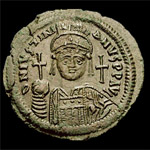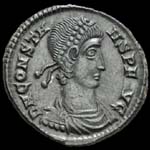
Due to the gradual devaluation of follis, in 346 it was replaced by the nummus centenionalis: even if the value of this coin is uncertain, the name "Centenionalis" suggests that it was worth hundredth part of a siliqua or miliarense.
With the monetary reform of Constans and Constantius II, the Pecunia maiorina (maiorina) replaced the follis, at that time devalued to 1.35 grams.


The nummus was reintroduced at the beginning of the Byzantine coinage with the monetary reform of Anastasius in 498, that was the last monetary system of the Roman empire based on a coin in bronze (the nummus) and a gold coin (the solidus).
The nummo was a bronze coin extremely small, with a diameter of around 8-10 mms, difficult to use due to the large number of coins to use even for small exchanges.
The new bronze coins was made as multiples of the nummus, i.e. coins for 40, 20, 10 and 5 nummis. On the obverse of this coin there was a stylized image of the emperor, and on the reverse the value of the coin was represented according to the Greek system of numeration (M=40, K=20, I=10, E=5). The value of 40 nummis was named as follis.


The term nummo is also used as synonym of sesterzio.